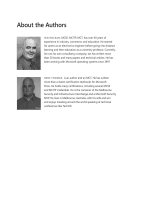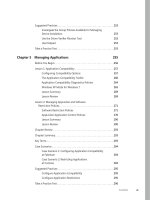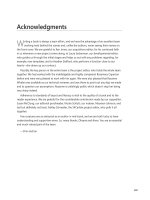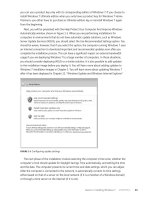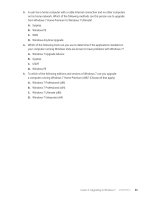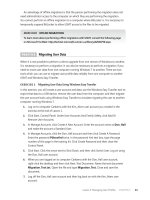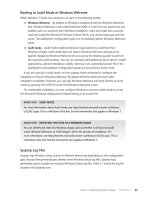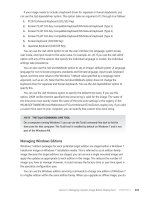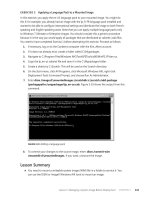Configuring Windows 7 (Training Kit) - Part 3 pps
Bạn đang xem bản rút gọn của tài liệu. Xem và tải ngay bản đầy đủ của tài liệu tại đây (182.54 KB, 10 trang )
xxi
Acknowledgments
W
riting a book is always a team effort, and we have the advantage of an excellent team
working hard behind the scenes and, unlike the authors, never seeing their names on
the front cover. We are grateful to Ken Jones, our acquisitions editor, for his continued faith
in us whenever a new project comes along, to Laura Sackerman, our developmental editor,
who guides us through the initial stages and helps us out with any problems regarding, for
example, new templates, and to Heather Stafford, who performs a function close to our
hearts—she draws up our contract.
Possibly the key person in the entire team is the project editor, who holds the whole team
together. We had worked with the indefatigable and highly competent Rosemary Caperton
before and were very pleased to work with her again. We were also pleased that Rozanne
Whalen was available as our technical reviewer, and was there to point out any slips we made
and to question our assumptions. Rozanne is unfailingly polite, which doesn’t stop her being
very sharp indeed.
Adherence to standards of layout and literacy is vital to the quality of a book and to the
reader experience. We are grateful for the considerable contribution made by our copyeditor,
Susan McClung; our editorial proofreader, Nicole Schlutt; our indexer, Maureen Johnson; and
last but definitely not least, Ashley Schneider, the S4Carlisle project editor, who pulls it all
together.
Few creatures are as antisocial as an author in mid-book, and we are both lucky to have
understanding and supportive wives. So, many thanks, Oksana and Anne. You are an essential
and much-valued part of the team.
—Orin and Ian
xxiii
Introduction
T
his training kit is designed for IT professionals who operate in enterprise environments
that use Windows 7 as a desktop operating system. You should have at least one year of
experience in the IT field, as well as experience implementing and administering any Windows
client operating system in a networked environment.
You should be able to install, deploy, and upgrade to Windows 7, including ensuring
hardware and software compatibility. Additionally, you should be able to configure
preinstallation and postinstallation system settings, Windows security features, network
connectivity applications included with Windows 7, and mobile computing. You should
also be able to maintain systems, including monitoring for and resolving performance and
reliability issues and have a basic understanding of Windows PowerShell syntax.
By using this training kit, you will learn how to do the following:
n
Install, upgrade, and migrate to Windows 7.
n
Deploy Windows 7.
n
Configure hardware and applications.
n
Configure network connectivity.
n
Configure access to resources.
n
Configure mobile computing.
n
Monitor and maintain systems that run Windows 7.
n
Configure backup and recovery options.
More Info FIND ADDITIONAL CONTENT ONLINE
As new or updated material that complements your book becomes available, it will be
posted on the Microsoft Press Online Windows Server and Client Web site. The type of
material you might find includes updates to book content, articles, links to companion
content, errata, sample chapters, and more. This Web site will is available at
and will be updated
periodically.
xxiv
Introduction
Lab Setup Instructions
The exercises in this training kit require a minimum of two client computers or virtual
machines running Windows 7 Enterprise or Ultimate editions. Instructions for configuring the
first of these computers are given in Chapter 1, “Install, Migrate, or Upgrade to Windows 7.”
Instructions for configuring the second of these computers are given in Chapter 6, “Network
Settings.” You need an additional hard disk (internal or external), formatted using the NTFS
file system, installed on the first of these computers.
You can obtain an evaluation version of Windows 7 Enterprise from the Microsoft
Download Center at the following address:
default.aspx.
All computers must be physically connected to the same network. We recommend that you
use an isolated network that is not part of your production network to do the practices in this
book. To minimize the time and expense of configuring physical computers, we recommend
you use virtual machines. To run computers as virtual machines within Windows, you can use
Hyper-V, Microsoft Virtual PC 2007, or third-party virtual machine software. To download
Virtual PC 2007, visit
Hardware Requirements
You can complete almost all the practice exercises in this book using virtual machines rather
than real hardware. The minimum and recommended hardware requirements for Windows 7
are listed in Table 1.
TABLE 1 Windows Server 2008 Minimum Hardware Requirements
HARDWARE COMPONENT MINIMUM REQUIREMENTS RECOMMENDED
Processor 1 GHz 32-bit (x86)
or 64-bit (x64) processor
2 GHz or faster
RAM 1 GB 2 GB
Disk space 40 GB 60 GB
Graphics adapter Supports DirectX 9 graphics
Has a Windows Display Driver
Model (WDDM) driver
Pixel Shader 2.0 hardware
32 bits per pixel
128 MB graphics memory
As minimum
requirement, but
with 256 MB of
graphics memory
xxv
Introduction
If you intend to implement two virtual machines on the same computer (which is
recommended), a higher specification will enhance your user experience. In particular,
a computer with 4 GB RAM and 60 GB available disk space can host all the virtual machines
specified for all the practice exercises in this book.
Using the DVD
The companion DVD included with this training kit contains the following:
n
Practice tests You can reinforce your understanding of how to configure Windows 7
by using electronic practice tests you customize to meet your needs from the pool of
Lesson Review questions in this book. Or you can practice for the 70-680 certification
exam by using tests created from a pool of 200 realistic exam questions, which give
you many practice exams to ensure that you are prepared.
n
An eBook An electronic version (eBook) of this book is included for when you do not
want to carry the printed book with you. The eBook is in Portable Document Format
(PDF), and you can view it by using Adobe Acrobat or Adobe Reader.
n
Sample chapters Sample chapters from other Microsoft Press titles on Windows
Server 2008. These chapters are in PDF format.
Digital Content for Digital Book Readers: If you bought a digital-only edition of this book, you can
enjoy select content from the print edition’s companion DVD.
Visit to get your downloadable content. This content
is always up to date and available to all readers.
How to Install the Practice Tests
To install the practice test software from the companion DVD to your hard disk, do the following:
1. Insert the companion DVD into your DVD drive and accept the license agreement.
A DVD menu appears.
note IF THE DVD MENU DOES NOT APPEAR
If the DVD menu or the license agreement does not appear, AutoRun might be disabled
on your computer. Refer to the Readme.txt file on the DVD-ROM for alternate installation
instructions.
2. Click Practice Tests and follow the instructions on the screen.
xxvi
Introduction
How to Use the Practice Tests
To start the practice test software, follow these steps:
1. Click Start, click All Programs, and then select Microsoft Press Training Kit Exam Prep.
A window appears that shows all the Microsoft Press training kit exam prep suites
installed on your computer.
2. Double-click the lesson review or practice test you want to use.
note LESSON REVIEWS VERSUS PRACTICE TESTS
Select the (70-680) Windows 7, Configuring lesson review to use the questions from the
“Lesson Review” sections of this book. Select (70-680) Windows 7, Configuring practice test
to use a pool of 200 questions similar to those that appear on the 70-680 certification exam.
Lesson Review Options
When you start a lesson review, the Custom Mode dialog box appears so that you can
configure your test. You can click OK to accept the defaults, or you can customize the number
of questions you want, how the practice test software works, which exam objectives you want
the questions to relate to, and whether you want your lesson review to be timed. If you are
retaking a test, you can select whether you want to see all the questions again or only the
questions you missed or did not answer.
After you click OK, your lesson review starts.
n
Article I To take the test, answer the questions and use the Next and Previous
buttons to move from question to question.
n
Article II After you answer an individual question, if you want to see which answers
are correct—along with an explanation of each correct answer—click Explanation.
n
Article III If you prefer to wait until the end of the test to see how you did, answer all
the questions and then click Score Test. You will see a summary of the exam objectives
you chose and the percentage of questions you got right, both overall and per
objective. You can print a copy of your test, review your answers, or retake the test.
Practice Test Options
When you start a practice test, you choose whether to take the test in Certification Mode,
Study Mode, or Custom Mode:
n
Certification Mode Closely resembles the experience of taking a certification exam.
The test has a set number of questions. It is timed, and you cannot pause and restart
the timer.
n
Study Mode Creates an untimed test during which you can review the correct
answers and the explanations after you answer each question.
xxvii
Introduction
n
Custom Mode Gives you full control over the test options so that you can customize
them as you like. In all modes, the user interface when you are taking the test is basically
the same but with different options enabled or disabled depending on the mode. The
main options are discussed in the previous section, “Lesson Review Options.”
When you review your answer to an individual practice test question, a “References”
section is provided that lists where in the training kit you can find the information that relates
to that question and provides links to other sources of information. After you click Test Results
to score your entire practice test, you can click the Learning Plan tab to see a list of references
for every objective.
How to Uninstall the Practice Tests
To uninstall the practice test software for a training kit, use the Program And Features option
in Control Panel.
Microsoft Certified Professional Program
The Microsoft certifications provide the best method to prove your command of current
Microsoft products and technologies. The exams and corresponding certifications are developed
to validate your mastery of critical competencies as you design and develop, or implement
and support, solutions with Microsoft products and technologies. Computer professionals
who become Microsoft-certified are recognized as experts and are sought after industry-wide.
Certification brings a variety of benefits to the individual and to employers and organizations.
More Info ALL THE MICROSOFT CERTIFICATIONS
For a full list of Microsoft certifications, go to
default.asp.
Technical Support
Every effort has been made to ensure the accuracy of this book and the contents of the
companion DVD. If you have comments, questions, or ideas regarding this book or the
companion DVD, please send them to Microsoft Press:
•
For additional support information regarding this book and the DVD-ROM (including answers
to commonly asked questions about installation and use), visit the Microsoft Press Technical
Support Web site at To connect directly
to the Microsoft Knowledge Base and enter a query, visit
For support information regarding Microsoft software, connect to .
CHAPTER 1 1
CHAPTER 1
Install, Migrate, or Upgrade
to Windows 7
E
xam 70-680, “Windows 7, Configuring,” is suitable for information technology (IT)
professionals with at least one year of experience working in a networked environment
whose job role involves or will involve installing and supporting the Windows 7 client
operating system. This first chapter focuses on installing Windows 7 through a clean
installation, upgrade, or migration. As an experienced IT professional, you know that
operating system installation is a critical starting point. The decisions that you make during
the installation process have significant ramifications for how people will use that computer
throughout its operational lifetime.
In this chapter, you will learn how to install Windows 7. You will learn the differences
between the various Windows 7 editions, the operating system’s hardware requirements;
the different installation sources that you can use for operating system deployment; how
to upgrade to Windows 7 from Windows Vista; and how to migrate user data to Windows 7
from Windows XP, Windows Vista, and other Windows 7 deployments.
Exam objectives in this chapter:
n
Perform a clean installation.
n
Upgrade to Windows 7 from previous versions of Windows.
n
Migrate user profiles.
Lessons in this chapter:
n
Lesson 1: Installing Windows 7 3
n
Lesson 2: Upgrading to Windows 7 25
n
Lesson 3: Managing User Profiles 34
2 CHAPTER 1 Install, Migrate, or Upgrade to Windows 7
Before You Begin
To complete the exercises in the practices in this chapter, you need the following:
n
Access to hardware that meets the Windows 7 minimum requirements as outlined
in the Introduction to this book.
n
A copy of the Windows 7 Enterprise or Ultimate edition installation media or an
evaluation version of Windows 7 Enterprise or Ultimate edition, which can be
downloaded from Microsoft’s Web site.
n
To perform the practice exercise at the end of Lesson 2, you need to have access to
a computer running Windows Vista that you can upgrade to Windows 7. You can use
a virtual machine for this practice exercise.
n
To perform the practice exercise at the end of lesson 3, you need to have access to
a removable USB storage device that can store approximately 1 GB of data.
real World
Orin Thomas
A
s an experienced IT professional, people come to you for advice on
computer-related subjects because you have knowledge and expertise that
they lack. When a new operating system is released, people who trust you will want
to know if you think they should start using it. They will want to know what features
it has that make it different from what they are using now. They will want to know
if their current hardware and software are compatible or if they will need a new
computer. Although this book focuses on deploying and supporting Windows 7 in
an organizational environment, many of the people that will seek out your advice
will be family, friends, and coworkers. If you are to give them good advice, you
need to know on what sort of hardware Windows 7 runs well and on what sort of
hardware it runs poorly. You need to be able to evaluate whether hardware devices
and software that they own work with Windows 7 or whether they are incompatible.
Before they upgrade, they need to know that their 5-year-old multifunction printer
and scanner do not work with Windows 7, rather than finding out after it is too late.
When it comes to providing advice to people that trust you about important things,
a best guess is not good enough.
